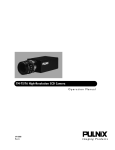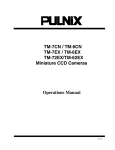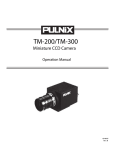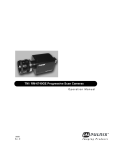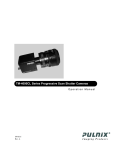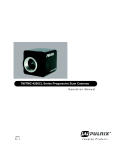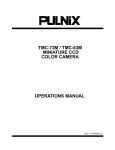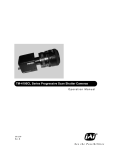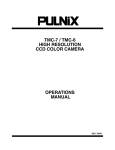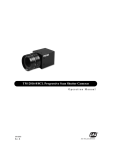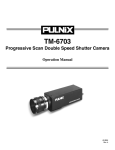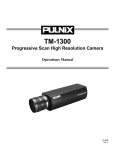Download Pulnix TM-250 Instruction manual
Transcript
TM-250 Miniature CCD Camera Operation Manual 69-0081 Rev. A Imaging Products Notice The material contained in this manual consists of information that is proprietary to PULNiX America, Inc., and may only be used by the purchasers of the product. PULNiX America, Inc. makes no warranty for the use of its product and assumes no responsibility for any errors which may appear or for damages resulting from the use of the information contained herein. PULNiX America, Inc. reserves the right to make changes without notice. Microsoft, Windows 98, Windows 95, Windows NT, and Windows Explorer are either registered trademarks or trademarks of Microsoft Corporation in the United States and/or other countries. Warranty All of our solid-state cameras have a full three-year warranty. If any such product proves defective during this warranty period, PULNiX America, Inc. will repair the defective product without charge for parts and labor or will provide a replacement in exchange for the defective product. This warranty shall not apply to any damage, defect or failure caused by improper use or inadequate maintenance. Certifications CE Compliance The TM-250 camera has been certified to conform to the requirements of Council Directive 89/336/EC for electromagnetic compatibility and to comply with the following European Standards: Immunity: Emissions: EN50082-2/1995 EN55011/EN61326-1, Class A All PULNiX products bearing the CE mark have been declared to be in conformance with the applicable EEC Council Directives. However, certain factory-installed options or customer-requested modifications may compromise electromagnetic compatibility and affect CE compliance. Please note that the use of interconnect cables that are not properly grounded and shielded may affect CE compliance. Contact PULNiX Applications Engineering Department for further information regarding CE compliance. FCC This equipment has been tested and found to comply with the limits for a Class A digital device, pursuant to Part 15 of the FCC Rules. These limits are designed to provide reasonable protection against harmful interference when the equipment is operated in a commercial environment. This equipment generates, uses and can radiate radio frequency energy and, if not installed and used in accordance with the instruction manual, may cause harmful interference to radio communications. Operation of this equipment in a residential area may cause harmful interference, in which case the user will be required to correct the interference at his own expense. WARNING A SS O C I AT I O N ® RM UL FI S I MEMBER REG TED IMA MA O G IN G TM-250 Operation Manual PULNiX America, Inc. 1330 Orleans Drive Sunnyvale, CA 94089 Tel:(408) 747-0300 Tel:(800) 445-5444 Fax:(408) 747-0880 E-mail: [email protected] www.pulnix.com AU T Changes or modifications to this unit not expressly approved by the party responsible for FCC compliance could void the user’s authority to operate the equipment. TE ED R PULNiX AMERICA, INC. REGISTERED TO ISO-9001 FILE #A3942 TM-250 Miniature CCD Camera i Table of Contents 1 Introduction . . . . . . . . . . . . . . . . . . . . . . . . . . . . . 1 1.1 1.2 1.3 1.4 1.5 Product Description. . Features . . . . . . . . . . Functional Options . . Applications . . . . . . . System Configuration. . . . . . . . . . . . . . . . . . . . . . . . . . . . . . . . . . . . . . . . . . . . . . . . . . . . . . . . . . . . . . . . . . . . . . . . . . . . . . . . . . . . . . . . . . . . . . . . . . . . . . . . . . . . . . . . . . . . . . . . . .1 .1 .2 .3 .3 2 Installation . . . . . . . . . . . . . . . . . . . . . . . . . . . . . . 4 2.1 Getting Started. . . . . . . . . . . . . . . . . . . . . . . . . . . . . . 4 2.1.1 2.1.2 2.1.3 2.2 Unpacking Instructions . . . . . . . . . . . . . . . . . . . . . . . . . . . . . . . . . . . . 4 Components List. . . . . . . . . . . . . . . . . . . . . . . . . . . . . . . . . . . . . . . . . 4 Accessories . . . . . . . . . . . . . . . . . . . . . . . . . . . . . . . . . . . . . . . . . . . . . 4 Camera Setup . . . . . . . . . . . . . . . . . . . . . . . . . . . . . . . 4 2.2.1 2.2.2 2.2.3 2.2.4 2.2.5 2.2.6 Connector Pin Configurations . . . . . . . . . . . . . . . . . . . . . . . . . . . . . . 4 Power Supply and Power Cable . . . . . . . . . . . . . . . . . . . . . . . . . . . . . 5 Attaching the Video Output . . . . . . . . . . . . . . . . . . . . . . . . . . . . . . . . 7 Attaching the Camera Lens . . . . . . . . . . . . . . . . . . . . . . . . . . . . . . . . 7 Auto-Iris Lens Setup . . . . . . . . . . . . . . . . . . . . . . . . . . . . . . . . . . . . . . 7 Monitor Display Mode . . . . . . . . . . . . . . . . . . . . . . . . . . . . . . . . . . . . 7 3 Operation . . . . . . . . . . . . . . . . . . . . . . . . . . . . . . . 8 3.1 Rear Panel Switches. . . . . . . . . . . . . . . . . . . . . . . . . . . 8 3.1.1 3.1.2 3.1.3 3.2 External Sync . . . . . . . . . . . . . . . . . . . . . . . . . . . . . . 12 3.2.1 3.2.2 3.3 Function Control . . . . . . . . . . . . . . . . . . . . . . . . . . . . . . . . . . . . . . . . 8 Shutter Control . . . . . . . . . . . . . . . . . . . . . . . . . . . . . . . . . . . . . . . . . 8 Field and Frame Modes. . . . . . . . . . . . . . . . . . . . . . . . . . . . . . . . . . . 11 Timing . . . . . . . . . . . . . . . . . . . . . . . . . . . . . . . . . . . . . . . . . . . . . . . . 13 Interfacing to Frame Grabbers . . . . . . . . . . . . . . . . . . . . . . . . . . . . . 13 Operating Modes . . . . . . . . . . . . . . . . . . . . . . . . . . . . 13 3.3.1 3.3.2 3.3.3 3.3.4 3.3.5 3.3.6 3.3.7 3.3.8 Standard Interlace Mode. . . . . . . . . . . . . . . . . . . . . . . . . . . . . . . . . . 14 Cyclic (Continuous) Shutter Mode . . . . . . . . . . . . . . . . . . . . . . . . . 14 Asynchronous Reset and Asynchronous Shutter . . . . . . . . . . . . . . . 14 External Sync Mode . . . . . . . . . . . . . . . . . . . . . . . . . . . . . . . . . . . . . 15 Reset-Restart Mode . . . . . . . . . . . . . . . . . . . . . . . . . . . . . . . . . . . . . 15 External Shutter Control . . . . . . . . . . . . . . . . . . . . . . . . . . . . . . . . . 15 Integration. . . . . . . . . . . . . . . . . . . . . . . . . . . . . . . . . . . . . . . . . . . . . 15 Non-Interlace Operation . . . . . . . . . . . . . . . . . . . . . . . . . . . . . . . . . 15 4 TM-250 External Signals . . . . . . . . . . . . . . . . . . . . 16 4.1 4.2 4.3 External VD . . . . . . . . . . . . . . . . . . . . . . . . . . . . . . . 16 External HD and Internal Sampling Clock . . . . . . . . . . . 16 Width Mode Reset-Restart Operation . . . . . . . . . . . . . 17 5 Operation Mode . . . . . . . . . . . . . . . . . . . . . . . . . . 18 5.1 Cyclic Mode . . . . . . . . . . . . . . . . . . . . . . . . . . . . . . . 18 5.1.1 5.1.2 5.1.3 5.1.4 5.2 No Discharge Operation . . . . . . . . . . . . . . . . . . . . . . . . . . . . . . . . . 18 Fast Shutter Cyclic Mode . . . . . . . . . . . . . . . . . . . . . . . . . . . . . . . . . 19 Trigger Position Reset/Restart Shutter Mode . . . . . . . . . . . . . . . . . 20 Trigger Width Reset/Restart Mode . . . . . . . . . . . . . . . . . . . . . . . . . 21 Asynchronous Operation. . . . . . . . . . . . . . . . . . . . . . . 22 TM-250 Miniature CCD Camera ii Table of Contents 5.2.1 5.2.2 5.2.3 5.2.4 5.2.5 5.2.6 TM-250 Strobe Asynchronous Shutter Mode . . . . . . . . . . . . . . . . . 22 Post-Reset Asynchronous Shutter Mode . . . . . . . . . . . . . . . . . . . . . 23 Pulse Width Asynchronous Shutter Mode . . . . . . . . . . . . . . . . . . . . 25 Pre-Reset Asynchronous Shutter Mode. . . . . . . . . . . . . . . . . . . . . . 25 Double Pulse Integration Mode . . . . . . . . . . . . . . . . . . . . . . . . . . . . 27 Pulse Width Integration Mode . . . . . . . . . . . . . . . . . . . . . . . . . . . . . 27 6 Troubleshooting . . . . . . . . . . . . . . . . . . . . . . . . . . 29 6.1 Problems and Solutions . . . . . . . . . . . . . . . . . . . . . . . 29 6.1.1 6.1.2 6.1.3 6.1.4 6.2 Symptom: No Video . . . . . . . . . . . . . . . . . . . . . . . . . . . . . . . . . . . . . 29 Symptom: Dark Video . . . . . . . . . . . . . . . . . . . . . . . . . . . . . . . . . . . . 29 Symptom: Non-Synchronized Video . . . . . . . . . . . . . . . . . . . . . . . . . 29 Symptom: Flickering Video in Reset/Restart Mode . . . . . . . . . . . . . 29 Information and Support Resources . . . . . . . . . . . . . . 30 7 Appendix . . . . . . . . . . . . . . . . . . . . . . . . . . . . . . . 31 7.1 Specifications . . . . . . . . . . . . . . . . . . . . . . . . . . . . . . 31 7.1.1 7.1.2 7.1.3 7.1.4 7.2 Product Specifications . . . . . . . . . . . . . . . . . . . . . . . . . . . . . . . . . . . 31 Physical Dimensions . . . . . . . . . . . . . . . . . . . . . . . . . . . . . . . . . . . . . 32 C-Mount Specifications . . . . . . . . . . . . . . . . . . . . . . . . . . . . . . . . . . 33 Front End Detail . . . . . . . . . . . . . . . . . . . . . . . . . . . . . . . . . . . . . . . . 34 Spectral Response . . . . . . . . . . . . . . . . . . . . . . . . . . . 34 TM-250 Miniature CCD Camera iii List of Figures FIGURE 1. TM-250 System Configuration . . . . . . . . . . . . . . . . . . . . . . . . . . . . 3 FIGURE 2. 12P-02S Interface Cable (optional). . . . . . . . . . . . . . . . . . . . . . . . . 6 FIGURE 3. Input Signals . . . . . . . . . . . . . . . . . . . . . . . . . . . . . . . . . . . . . . . . . . 12 FIGURE 4. TM-250 Timing Chart . . . . . . . . . . . . . . . . . . . . . . . . . . . . . . . . . . 13 FIGURE 5. External VD . . . . . . . . . . . . . . . . . . . . . . . . . . . . . . . . . . . . . . . . . . 16 FIGURE 6. Proper Operation . . . . . . . . . . . . . . . . . . . . . . . . . . . . . . . . . . . . . 16 FIGURE 7. Proper Operation . . . . . . . . . . . . . . . . . . . . . . . . . . . . . . . . . . . . . 17 FIGURE 8. Illegal Operation . . . . . . . . . . . . . . . . . . . . . . . . . . . . . . . . . . . . . . 17 FIGURE 9. No Discharge Operation (Frame Accumulation Mode). . . . . . . . 19 FIGURE 10. No Discharge Operation (Field Accumulation Mode) . . . . . . . . . 19 FIGURE 11. High-Speed Cyclic Shutter Mode Timing . . . . . . . . . . . . . . . . . . . 20 FIGURE 12. Trigger Position Reset/Restart Mode Timing . . . . . . . . . . . . . . . . 21 FIGURE 13. Trigger Width Reset/Restart Shutter Mode Timing . . . . . . . . . . . 22 FIGURE 14. Strobe Asynchronous Shutter Mode Timing. . . . . . . . . . . . . . . . . 23 FIGURE 15. Post-Reset Asynchronous Shutter Mode Timing . . . . . . . . . . . . . 24 FIGURE 16. Pulse Width Asynchronous Shutter Mode . . . . . . . . . . . . . . . . . . 25 FIGURE 17. Pre-Reset Asynchronous Shutter Mode . . . . . . . . . . . . . . . . . . . . 26 FIGURE 18. Double Pulse Integration Mode . . . . . . . . . . . . . . . . . . . . . . . . . . 27 FIGURE 19. Pulse Width Integration Mode . . . . . . . . . . . . . . . . . . . . . . . . . . . 28 FIGURE 20. Physical Dimensions . . . . . . . . . . . . . . . . . . . . . . . . . . . . . . . . . . . 32 FIGURE 21. Combination With “CS-Mount” Camera . . . . . . . . . . . . . . . . . . . 33 FIGURE 22. Front End Detail . . . . . . . . . . . . . . . . . . . . . . . . . . . . . . . . . . . . . . 34 FIGURE 23. Spectral Response . . . . . . . . . . . . . . . . . . . . . . . . . . . . . . . . . . . . . 34 TM-250 Miniature CCD Camera iv List of Tables TABLE 1. 12-Pin Connector Configuration . . . . . . . . . . . . . . . . . . . . . . . . . . . . . . . . . .5 TABLE 2. Shutter Speed Control in High-Speed Cyclic Shutter Mode . . . . . . . . . . . . .8 TABLE 3. Shutter Speed Control in Post-Reset Asynchronous Shutter Mode . . . . . .10 TABLE 4. Shutter Speed Control in Pre-Reset Asynchronous Shutter Mode . . . . . . .10 TABLE 5. Shutter Speed Control in High-Speed Cyclic Shutter Mode . . . . . . . . . . . .18 TABLE 6. Trigger Position Reset/Restart Shutter Mode . . . . . . . . . . . . . . . . . . . . . . .21 TABLE 7. Trigger Width Reset/Restart Shutter Mode . . . . . . . . . . . . . . . . . . . . . . . . .22 TABLE 8. Strobe Asynchronous Shutter Mode . . . . . . . . . . . . . . . . . . . . . . . . . . . . . .22 TABLE 9. Shutter Speed Control in Post-Reset Asynchronous Shutter Mode . . . . . .24 TABLE 10. Pulse Width Asynchronous Shutter Mode . . . . . . . . . . . . . . . . . . . . . . . . . .25 TABLE 11. Shutter Speed Control in Pre-Reset Asynchronous Shutter Mode . . . . . . .26 TABLE 12. Double Pulse Integration Mode . . . . . . . . . . . . . . . . . . . . . . . . . . . . . . . . . .27 TABLE 13. Pulse Width Integration Mode . . . . . . . . . . . . . . . . . . . . . . . . . . . . . . . . . . .28 TABLE 14. TM-250 Product Specifications Table . . . . . . . . . . . . . . . . . . . . . . . . . . . . . .31 TM-250 Miniature CCD Camera August 30, 2001 TM-250 Miniature CCD Camera Operation Manual 1 Introduction 1.1 Product Description The TM-250 is an inexpensive, high-quality camera that meets a variety of application requirements. Featuring an advanced Hyper-HAD1 interline transfer 1/2" CCD imager, this miniaturized highresolution camera offers many standard and optional features at a very affordable price. A CCIR-format model, the TM-260, is also available. 1.2 Features • Variable electronic shutter and random CCD integration The substrate drain-type shutter mechanism provides a superb picture at various speeds without smearing. The electronic shutter rate can be externally adjusted, from 1/60 to 1/10,000 (1/29,100 in some operating modes) in discrete steps, via a manually controlled DIP switch on the back panel. • Miniaturized and lightweight The use of a CCD image sensor in the video camera module and the development of special mini C-mount lenses allow the TM-250 to be compact, lightweight, robust, and small enough to operate just like a remoted head. • High sensitivity The TM-250 camera is one of the most low-light sensitive 1/2" CCD cameras available today. This feature is especially important when using the faster shutter speeds. The CCD detects images into the near-infrared spectrum. It requires only 1.0 lux of minimum illumination and 0.5 lux minimum illumination at maximum gain. In general, this allows the use of a higher lens F-value while providing a greater field depth and sharper images. • Low lag/high resistance to image burning 1. Hyper-HAD is a trademark of SONY Corporation. TM-250 Miniature CCD Camera Page 2 Introduction Because the CCD is highly resistant to image burning, the camera may be exposed to bright objects for a long period of time. Because a “smear” phenomenon may occur when shooting a very bright object, we recommend an infrared cutoff filter to obtain a clear picture (optional). • AGC/MGC selection, manual gain control and gamma adjustment These adjustments, which are particularly important in vision system applications, are externally adjustable via switches on the rear plate. • Genlock circuit A genlock circuit is built in to accept external sync for applications in which external sync is required. • High resistance to magnetic field and vibration/mechanical shock The CCD imager’s rugged design allows it to withstand strong vibration and shock with little or no noise appearing in the picture. Since the TM-250 is not influenced by a magnetic field, it will produce stable images even when placed next to objects such as electric furnaces, welding machines or NMR scanners. • Quick start-up and low power consumption Image capture can begin within a second after turning on the camera. The power consumption is only 2.5W. This makes the camera excellent for use with battery-operated systems. • Camera-mounting flexibility The TM-250 has tapped holes on all four sides to allow a tripod mount to be installed from any angle. • Three-year warranty The CCD solid-state image sensor allows the camera to maintain a superior performance level indefinitely while requiring virtually no maintenance. PULNiX backs all of the TM series cameras with a three-year warranty. Warning: Unscrewing the camera cover or opening the camera in any way will void this warranty unless prior written approval is obtained from the factory. 1.3 Functional Options • Adjustable backfocus front end • Internal IR Cut Filter (OP3-1) • Optical Filter Removal (OP3-2) • Glassless CCD Imager (OP21) • Low impedance (75Ω) termination • NIR CCD • SONY pinouts TM-250 Miniature CCD Camera Page 3 Introduction 1.4 Applications The miniature size of the TM-250 camera eliminates the need for a remoted imager camera in all but the most confined spaces. This camera fits easily, both physically and functionally, into all types of machine vision, automated inspection, and related applications. Other uses include remotely piloted vehicles, miniature inspection devices, surveillance, microscopes, and medical equipment. 1.5 System Configuration Figure 1 (below) presents a typical system configuration for the TM-250. FIGURE 1. TM-250 System Configuration SECURE HATCH IN PLACE AFTER FINAL ADJUSTMENTS. Computer with Frame Grabber Board 0 OFF 1.0 FRM 0 0 OFF MGC CYC 0 Power Ext. Sync Trigger VIdeo Output* GAIN POWER VIDEO * Video Output is the same as BNC connector Monitor TM-250 Miniature CCD Camera Page 4 Installation 2 Installation The following instructions are provided to help you to set up your video camera system quickly and easily. We suggest that you read through these instructions before unpacking and setting up your camera system. 2.1 Getting Started 2.1.1 Unpacking Instructions We recommend that you save the original packing cartons for the cameras and lenses in case you need to return or exchange an item. We also recommend that you bench-test any equipment being sent to another location for field installation to assure that everything is fully operational as a system. 2.1.2 Components List Please begin by checking your order against the Components List (below) to assure that you have received everything as ordered, and that nothing has been overlooked in the packing materials. If any item is missing, please contact your PULNiX representative immediately. • TM-250 camera • TM-250/260 data sheet • TM-250 operation manual (if ordered) 2.1.3 Accessories Following is a list of additional accessories or equipment that may be recommended or required for your particular application. Please check with your PULNiX representative before installing your video system to determine what you might need. • Power Cable: 12P-02S Interface Cable • Power Supply: PD-12U series, and K series. 2.2 Camera Setup 2.2.1 Connector Pin Configurations The TM-250 has a 12-pin connector for power input. In general, Pin #1 is Ground and Pin #2 is +12V DC. The other pins handle a number of other input and output functions, as shown in the table below. 9 1 2 3 10 11 12 4 7 6 5 TM-250 Miniature CCD Camera 8 Page 5 Installation TABLE 1. 12-Pin Connector Configuration Pin Description Pin Description 1 GND 7 VD Input 2 +12V DC 8 GND 3 GND 9 HD Input 4 Video Out 10 N/C 5 GND 11 N/C 6 VINIT/TRIG Input 12 GND 2.2.2 Power Supply and Power Cable 2.2.2 (a) Power Supplies PULNiX recommends the following power supplies: K25-12V 110V AC/12V DC 2.1A power supply (OEM type) K50-12V 110V AC/12V DC 4.2A power supply (OEM type) PD-12UU 100-240V AC/12V DC 1.2A universal voltage power supply PD-12UP PD-12UU with12-pin connector US plug PD-12UE PD-12UU European plug PD-12UEP PD-12UU with 12-pin connector European plug If you are providing power through the 12-pin connector, the PD-12UUP power supply is available with the 12-pin mating connector already attached to the leads from the power supply. The PD-12UU power supply can be connected to the PULNiX power cable via a terminal strip or directly. When wiring the PD-12 power supply directly, please note the following: • The lead ends must be twisted together and tin soldered for strength and electrical continuity. • Shrink tubing or a similar insulator should be used to prevent exposed leads from touching. • The +12V lead is marked with a red stripe or white lettering; be sure not to reverse the leads. • All connections must be properly insulated to prevent shorting. 2.2.2 (b) PULNiX Power Cables If you are using PULNiX power cables, such as the 12P-02S, please refer to the appropriate pin-out diagram. The color coded leads use Gray for Ground and Yellow for +12V DC. TM-250 Miniature CCD Camera Page 6 Installation FIGURE 2. 12P-02S Interface Cable (optional) Flying Leads 1 32mm 2,000mm± 10mm (2 Meters) 1 PC-12P (Hirose Part #10A-10P-12S/PC12P) 12P-02S Interface Cable Note: Pin# Lead Color Function Pin# Lead Color Function 1 Gray GND 7 Black coax VD Input 2 Yellow +12V DC 8 White coax shield GND 3 Red coax shield GND 9 White coax HD Input 4 Red coax Video 10 Brown N/C 5 Orange coax shield GND 11 Blue N/C 6 Orange coax VINIT/TRIG 12 Black coax shield GND Make sure that the unused leads are not touching and that there is no possibility that the leads could short due to exposed wires. 2.2.2 (c) “K” Series Power Supplies The “K” series power supplies are designed primarily for OEM users who will be mounting the power supply inside a protective enclosure. For use in exposed situations, the PD-12UU series power supplies are recommended. Follow the directions below to connect a “K” series power supply. 1. 2. 3. Attach the 110V line cord to the two terminals marked “AC.” Do not plug the cord into a 110V AC socket until you have completed steps 2 and 3. Attach the Gray and Yellow leads of the power cable to the Ground and 12V DC terminals, respectively. Replace the plastic terminal guard on the power supply. 2.2.2 (d) Building Your Own Power Cable Consult the pin-out for the camera purchased. Connect the Ground and +12V power leads of the PD12UUP power connector to Pin #1 and Pin #2, respectively (power must be DC regulated, and of sufficient current to properly power the camera). 2.2.2 (e) Attaching the Power Cable to the Connector The 12-pin connector is keyed and will only fit in one orientation. Follow these directions to properly attach the power cable to the camera connector: 1. 2. 3. Rotate the connector while applying slight pressure until the keyways line up. Press the connector into place until firmly seated. Plug the power cord into the 100V AC socket. This will power the camera up. TM-250 Miniature CCD Camera Page 7 Installation 2.2.3 Attaching the Video Output Most users utilize the BNC connector for video output from the camera. Connect the output from the camera to the input of your monitor, VCR, or switching device. The input of the monitor should be balanced for 75Ω termination. Standard RG-59 type coaxial cable should carry a full video signal for up to 500 feet. To output the video and input the power and sync to a camera over a single cable, use the PULNiX multi-conductor cables, such as the 12P-02S, etc. The mini coaxial leads in PULNiX multi-conductor cables are designed for short runs of no longer than 100 feet. Note: Make sure that no extraneous wires are visible which could cause a short. 2.2.4 Attaching the Camera Lens The TM-250 camera accepts 1/2" or larger format size C-mount lenses. To attach the C-mount lens to the camera, carefully engage the threads and rotate the lens clockwise until it firmly seats on the mounting ring. Do not force the lens if it does not seat properly. Please note that some lenses with extremely long flangebacks may exceed the mounting depth of the camera. 2.2.5 Auto-Iris Lens Setup Auto-iris lenses with full video input can be used with the PULNiX TM-250, although this camera model does not come equipped with auto-iris output. Note: Make sure that the power is removed from the camera before connecting or disconnecting the auto-iris lens. There is a small chance that the auto-iris lens could be damaged by plugging or unplugging it while the camera is powered up. Power down the camera before installing the auto-iris lens. To install the auto-iris lens in a PULNiX camera without an auto-iris output, wire the signal (video) on the lens into the terminal 1 Vp-p video output on the camera. Point the camera at a light area and then quickly towards a darker area. If everything is working properly, the iris should adjust for the light change. 2.2.6 Monitor Display Mode For monitoring real-time video, connect the video output to a video monitor or other device. TM-250 Miniature CCD Camera Page 8 Operation 3 Operation 3.1 Rear Panel Switches 3.1.1 Function Control 1. 2. 3. 4. 5. 6. 7. F2: Up = Function 2 ON UP .45 FLD S3 S1 F2 Down = Function 2 OFF S2 F1 S0 AGC ASY F1: Up = Function 1 ON Down = Function 1 OFF 0 0 OFF 1.0 FRM Gamma: Up = 0.45 0 0 MGC CYC OFF DOWN Down = 1.0 AGC/MGC switch: Up =AGC (Automatic Gain Control) Down =MGC (Manual Gain Control)* * When MGC is selected, the camera gain can be adjusted using the potentiometer on the back plate. FLD/FRM: Up = FLD (Field Mode) Down = FRM (Frame Mode) * Select FRM for strobe applications and FLD for high shutter speed applications. See Section 3.1.3 on page 11 for details. ASY/CYC: Up = Asynchronous mode (randomly resettable) Down = Cyclic mode Shutter (free-running only) S3 to S0: See Section 3.1.2 on page 8. Note: Functions of the F1 and F2 switches vary depending on the operating mode selected. 3.1.2 Shutter Control Shutter speeds on the TM-250 can be controlled using DIP switches S3, S2, S1, and S0. The following tables show the various switch settings in different operating modes. TABLE 2. Shutter Speed Control in High-Speed Cyclic Shutter Mode Switch Position F1 OFF ASY CYC S3 0 S2 0 S1 0 S0 0 Shutter Speed (Sec.) Down Down Down Down Down Down 1/30 (no shutter) Down Down Down Down Down Up 1/60 Down Down Down Down Up Down 1/100 Down Down Down Down Up Up 1/120 Down Down Down Up Down Down 1/250 Down Down Down Up Down Up 1/500 Down Down Down Up Up Down 1/1,000 Down Down Down Up Up Up 1/5,000 Down Down Up Down Down Down 1/2,100 TM-250 Miniature CCD Camera Page 9 Operation TABLE 2. Shutter Speed Control in High-Speed Cyclic Shutter Mode Switch Position F1 OFF ASY CYC S3 0 S2 0 S1 0 S0 0 Shutter Speed (Sec.) Down Down Up Down Down Down Up Down Down Up 1/2,800 Up Down 1/3,500 Down Down Up Down Up Up 1/4,400 Down Down Up Up Down Down 1/6,200 Down Down Down Up Up Down Up 1/10,200 Down Up Up Up Down 1/29,100 F2: not applicable TM-250 Miniature CCD Camera Page 10 Operation TABLE 3. Shutter Speed Control in Post-Reset Asynchronous Shutter Mode Switch Position F1 OFF ASY CYC S3 0 S2 0 S1 0 S0 0 Shutter Speed (Sec.) Down Up Down Down Down Up 1/60 Down Up Down Down Up Down 1/120 Down Up Down Down Up Up 1/250 Down Up Down Up Down Down 1/500 Down Up Down Up Down Up 1/1,000 Down Up Down Up Up Down 1/1,600 Down Up Down Up Up Up 1/1,800 Down Up Up Down Down Down 1/2,100 Down Up Up Down Down Up 1/2,400 Down Up Up Down Up Down 1/2,800 Down Up Up Down Up Up 1/3,500 Down Up Up Up Down Down 1/4,400 Down Up Up Up Down Up 1/6,200 Down Up Up Up Up Down 1/10,200 F2 Up: SYNC signal is continuous. F2 Down: SYNC signal is available in one field right after VINIT. TABLE 4. Shutter Speed Control in Pre-Reset Asynchronous Shutter Mode Switch Position F1 OFF ASY CYC S3 0 S2 0 S1 0 S0 0 Shutter Speed (Sec.) Up Up Down Down Down Up 1/29,100 Up Up Down Down Up Down 1/10,200 Up Up Down Down Up Up 1/6,200 Up Up Down Up Down Down 1/4,400 Up Up Down Up Down Up 1/3,500 Up Up Down Up Up Down 1/2,800 Up Up Down Up Up Up 1/2,400 Up Up Up Down Down Down 1/2,100 Up Up Up Down Down Up 1/1,800 Up Up Up Down Up Down 1/1,600 Up Up Up Down Up Up 1/1,500 F2 Up: SYNC signal is continuous. F2 Down: SYNC signal is available in one field right after VINIT. TM-250 Miniature CCD Camera Page 11 Operation 3.1.3 Field and Frame Modes The standard factory setting for the TM-250 camera is FRAME MODE. The field and frame integration mode is selectable using the switch on the rear panel of the camera. The frame integration is used to separate all CCD pixels. The exposure of Odd and Even fields generates the full frame image shown in the figure below. 1 2 3 261 262 263 264 524 525 1 2 3 261 262 263 264 524 525 1 2 3 261 262 263 264 524 525 HD VD Odd Field Even Field Odd Field Even Field Odd Field Odd Even Odd Even Odd Even Odd Even Odd Even Odd Even Even Field Frame Integration Field Integration 3.1.3 (a) Field Mode In Field mode, two horizontal rows are scanned (binned) simultaneously. At each interlace scan, the scanned pairs are changed. Thus the sensitivity of the CCD is doubled for one field of integration. When compared to Frame mode, in which each horizontal row is scanned simultaneously, the CCD obtains the same sensitivity in half the time period. This mode is useful when Shutter is used. The field integration is done by combining two pixel rows (binning) together and each pair alternates as interlace scan is generated. Row 1 is binned with row 2, and row 3 is binned with row 4. In Field 2, row 2 is binned with row 3, row 4 with row 5, and so on. The field mode is very effective in shutter mode since the pixel sensitivity is doubled for field integration (1/60 sec) and equals with frame mode (one row at 1/30 sec). Since shutter mode is only one field output per shutter and darker than normal image, two-row binning is effective. This mode also reduces interlace moire when a sharp horizontal pattern is observed. For higher pixel definition such as gauging and sub-pixel interpolation, Frame mode operation is recommended. Moire is unnoticeable because of alternating two-row scanning. The vertical resolution in Field mode is not as good as that in Frame mode, but it is sufficient to view the full vertical resolution of the TV format. 3.1.3 (b) Frame Mode In Frame mode, each horizontal row is scanned as interlace scanning. The integration of each pixel is one frame period. In Frame mode, vertical pixel resolution is good, and the exact location is obtained. In comparison with Field mode, however, Frame mode has the disadvantage of showing vertical Moire. Frame mode should be used in applications that need strobe lighting, because full frame resolution is achieved in this mode. For higher pixel definition such as gauging and sub-pixel interpolation, Frame mode operation is recommended. TM-250 Miniature CCD Camera Page 12 Operation 3.2 External Sync The TM-250 can accept external sync from an external sync generator or frame grabber. Its input specifications are: Internal/External auto switch fH=15.734 KHz ±5%, fV=59.95 Hz ±5% Note: FIGURE 3. The TM-250 has a one (1) horizontal line delay between the input VD signal and the output video. If external vertical drive (VD) is applied to the camera, it may cause the video output to be delayed 1 HD (1 HD = ~64.0 µs). If the imaging system is capable of automatically detecting the start of video (within a few HD), then no problem will exist. If it is not capable of automatically detecting the start of video, you may need to reconfigure the video capturing sequence to delay video acquisition of 1HD. Input Signals 1/f(horizontal) +5Volts HD TTL Level 0 Volts 3 - 5µsec 1/60 +5Volts VD TTL Level 0 Volts 1 to 9HD TM-250 Miniature CCD Camera Page 13 Operation 3.2.1 Timing FIGURE 4. TM-250 Timing Chart HD 6.36µSec 819 91 768 B40 B1 40 757 758 759 760 761 762 763 764 765 766 767 768 3 B1 B2 B3 1 2 3 4 5 6 7 8 9 10 D1 22 D22 77 B40 B1 40 CCD photo sensors allocation Optical black period H register stop period Optical black period Image sensing period Dummy H register CCD output signal Effective picture period 154 H BLK 10.76µSec CBRK Composite video output 21 1.47µSec 70 H SYNC 4.89µSec 63.56µSec 910 (1 horizontal line) 3.2.2 Interfacing to Frame Grabbers The TM-250 camera can be connected to a frame grabber using either the 12-pin connector or the BNC connector on the rear panel of the camera. 3.3 Operating Modes Besides normal operation, the TM-250 supports the following versatile operations that can be selected by the DIP switch on the rear panel of the camera: • Standard Interlace Mode Field integration Mode Frame Integration Mode • External Sync Mode • Non-interlace Mode • Cyclic (Continuous) Shutter Mode • Asynchronous Reset and Asynchronous Shutter TM-250 Miniature CCD Camera Page 14 Operation • Reset-Restart Mode Frame Integration Mode Field Integration Mode • Reset-Restart Mode with Electronic Shutter Frame Integration Mode Field Integration Mode • Integration Mode (Strobe application) 3.3.1 Standard Interlace Mode 3.3.1 (a) Field Mode and Frame Mode The field and frame integration mode is selectable. The frame integration is used to separate all CCD pixels and the exposure of Odd and Even fields generate the full frame image shown in the figure below. 3.3.1 (b) Field Mode Binning The field integration is done by combining two pixel rows (binning) together, each pair alternating as interlace scan is generated. Row 1 is binned with row 2, and row 3 is binned with row 4. In Field 2, row 2 is binned with row 3, row 4 with row 5, and so on. Field mode is very effective in shutter mode because the pixel sensitivity is doubled for field integration (1/60 sec) and equals frame mode (one row at 1/30 sec). Because Shutter mode is only one field output per shutter and darker than normal image, two-row binning is effective. This mode also reduces interlace moire when a sharp horizontal pattern is observed. For higher pixel definition such as gauging and sub-pixel interpolation, Frame mode operation is recommended. 3.3.2 Cyclic (Continuous) Shutter Mode With back-plate shutter control, the TM-250 operates at the internally predefined shutter speeds. Each field output is exposed for the same period. The shutter control varies the substrate discharge timing. The duration between the shutter pulse and transfer gate timing (11H from VD edge) decides the exposure time (16H for CCIR). The following three cyclic shutter modes are available: • High-Speed Cyclic Shutter mode • Trigger Position Reset/Restart Shutter mode • Trigger Width Reset/Restart Shutter mode Contact PULNiX for timing charts of various cyclic shutter modes. 3.3.3 Asynchronous Reset and Asynchronous Shutter By supplying VINIT pulse on pin #6, the camera can be reset asynchronously. In this mode, when VINIT is kept high, it continuously discharges the CCD and outputs the field video signal upon the negative going edge. The output stays continuous during VINIT low. The first field output is always Odd. TM-250 Miniature CCD Camera Page 15 Operation The following four asynchronous shutter modes are available: • Strobe Asynchronous Shutter Mode • Pre-Reset Asynchronous Shutter Mode • Post-Reset Asynchronous Shutter Mode • Pulse Width Asynchronous Shutter Mode Please contact PULNiX for timing charts of various asynchronous shutter modes. 3.3.4 External Sync Mode TM-250 accepts standard RS-170 external sync, which is defined as horizontal sync (HD) and vertical sync (VD). The phase-locked loop jitter is designed to be the minimum (< 5ns) in this category using the latest PLL chip. The wide capture range enables the camera to operate at an extended temperature range (optional) of -35°C to 65°C. HD and VD input is TTL level and the high impedance is 100KΩ or 75Ω (optional). 3.3.5 Reset-Restart Mode Rather than using VINIT as asynchronous reset, the camera can be reset using EXT VD. In this mode, the camera needs multiple VD pulses to output valid images, depending on whether it is set to Field or Frame mode. Usually, the first field (Field mode) or the first frame (Frame mode) are garbage because of previous signal residuals prior to reset. A frame grabber has to know which frame or field to capture. External HD must be applied for this operation. 3.3.6 External Shutter Control The shutter speed or exposure can be controlled with external pulse (TRIG) in this mode. In combination with Reset-Restart Pulse (EXT VD), the camera can be externally controlled for imagecapture timing as well as for exposure time. This is an excellent application for capturing multiple images (two fields of images) of indexing objects under various lighting or brightness conditions. When Frame mode is selected, the full vertical resolution is achieved by taking two fields of shutter images, whether or not you are using an electronic shutter. 3.3.7 Integration When integration control (VINIT) is low, the CCD imager keeps integrating. When the signal returns to high, it enables the charge transfer for video output. This mode integrates longer than one field. With strobe light application, it can capture randomly strobed images during the integration. It also increases the exposure time to enhance low-light viewing. 3.3.8 Non-Interlace Operation With non-interlace external sync, the camera operates at non-interlace scanning. External VD must be generated at integer of 262H ± 8H. (Standard interlace is 262.5 H) TM-250 Miniature CCD Camera Page 16 TM-250 External Signals 4 TM-250 External Signals This section explains how the external signals (VD and HD) and shutter trigger signal (VINIT or TRIG) must be fed in Async Mode operation, Integration Mode operation, and Reset-Restart operation. 4.1 External VD The TM-250 I/F circuit intentionally delays the external VD for two pixel clock period. This ensures that the phase of external HD comes earlier than that of VD with any cable length and absorbs the effect of jitter caused by the user's sync generators. Assuming that the device propagation delay is more than zero nanoseconds and the external VD timing is created by the edge of external HD, the HD must come earlier than VD. Some sync generators, however, produce both VD and HD exactly in phase. In this case, external factors like jitter or parasitic cable effects may cause VD to come earlier than HD as shown in Figure 5 below. FIGURE 5. External VD EXT HD EXT VD (R.R.) Two-pixel delay Internal VD 4.2 External HD and Internal Sampling Clock To ensure stable operation without influence of jitter, the TM-250 latches Shutter Trigger Pulse (TRIG) using internal sampling clock called HCLK (half line clock). The frequency of HCLK is double of the external HD and two pixels earlier than external HD in terms of timing. Figure 6 below shows that the TRIG is latched in 1/2 line later for this reason. FIGURE 6. Proper Operation EXT HD Two pixels earlier HCLK Sample Sample TRIG TRIG detected TM-250 Miniature CCD Camera Sample Page 17 TM-250 External Signals 4.3 Width Mode Reset-Restart Operation In Width Mode Reset-Restart operation, the leading edge and trailing edge of TRIG must both be synchronized with external HD. In addition, the duration must be 1 line or longer in one-line step. If the TRIG does not meet these conditions, the exposure time may vary from the position and the field. Figure 7 below illustrates the proper operation with constant 2-line exposure period. Figure 8, on the other hand, illustrates the illegal operation where the exposure time varies by the position of TRIG. Shutter Trigger generates 1-line long-exposure at position A and 2-line-long exposure at position B because the TRIG pulse is clocked in the same timing but the termination does not have the same timing. The same happens by the difference of field (odd or even). FIGURE 7. Proper Operation HCLK EXT HD Sample TRIG FIGURE 8. Illegal Operation HCLK EXT HD TRIG (Case A) Exposure (A) TRIG (Case B) Exposure (B) Clocked in here TM-250 Miniature CCD Camera Page 18 Operation Mode 5 Operation Mode 5.1 Cyclic Mode TABLE 5. Shutter Speed Control in High-Speed Cyclic Shutter Mode F1 OFF ASY CYC S3 0 S2 0 S1 0 S0 0 Exposure Time Down Down Down Down Down Down 1/30 Down Down Down Down Down Up 1/60 Down Down Down Down Up Down 1/100 Down Down Down Down Up Up 1/120 Down Down Down Up Down Down 1/250 Down Down Down Up Down Up 1/500 Down Down Down Up Up Down 1/1,000 Down Down Down Up Up Up 1/5,000 Down Down Up Down Down Down 1/2,100 Down Down Up Down Down Up 1/2,800 Down Down Up Down Up Down 1/3,500 Down Down Up Down Up Up 1/4,400 Down Down Up Up Down Down 1/6,200 Down Down Up Up Down Up 1/10,200 Down Down Up Up Up Down 1/29,100 F2: not applicable. 5.1.1 No Discharge Operation In this cyclic operation, the camera generates its own synchronization signal and cyclically transfers the photo-charge. Since no discharge occurs, the one full frame time (60mS) is the exposure time for both fields in Frame Accumulation mode, as shown in Figure 9 below, and one full field time (30mS) in Field mode as shown in Figure 10 on page 19. The discharge pulse dumps photo-electrons accumulated in the photoreceptor which mechanism is called electronic shutter. Since the discharge pulse is not employed in this mode, we refer this mode to “NO” shutter. TM-250 Miniature CCD Camera Page 19 Operation Mode FIGURE 9. No Discharge Operation (Frame Accumulation Mode) Internal VD A Exposure (ODD) A A Transfer (ODD) B Exposure (EVEN) B B Video Out B A A B B FIGURE 10. No Discharge Operation (Field Accumulation Mode) Internal VD Exposure (ODD) A A A A A B B B B B Transfer (ODD) Exposure (EVEN) Transfer (EVEN) Video Out A+B A+B A+B A+B A+B 5.1.2 Fast Shutter Cyclic Mode In this shutter mode, the camera generates its own synchronization signal and cyclically carries out the internal shutter operation. The discharge and transfer repeats in every field at a predefined timing. The discharge occurs in every line and stops at the defined timing in one field. The duration between the last discharge and transfer determines exposure time. TM-250 Miniature CCD Camera Page 20 Operation Mode FIGURE 11. High-Speed Cyclic Shutter Mode Timing Internal VD DSUB pulse Transfer Exposure Video Out 5.1.3 Trigger Position Reset/Restart Shutter Mode The shutter trigger pulse (TRIG) needs to synchronize with Reset-Restart (EXT VD) pulse. It should be 2 lines or more in width. The leading edge of TRIG pulse produces DSUB (discharge) pulse and starts the exposure. The transfer (read-out) occurs at the 11th line after EXT VD pulse is fed. A full picture field can be obtained in every field. The TRIG must be wider than one line. TM-250 Miniature CCD Camera Page 21 Operation Mode FIGURE 12. Trigger Position Reset/Restart Mode Timing EXT VD (R.R.) TRIG DSUB pulse Transfer Exposure Video Out TABLE 6. Trigger Position Reset/Restart Shutter Mode F1 OFF ASY CYC S3 0 S2 0 S1 0 S0 0 TRIGGER Polarity Up Down Up Up Up Down Positive F2: not applicable. 5.1.4 Trigger Width Reset/Restart Mode The timing of the trigger pulse is not critical. It is, rather, the duration (width) that is important for precise exposure time. The shutter pulse does not need to synchronize with Reset-Restart (EXT VD), and can synchronize with moving objects. A full picture field can be obtained on every other field, rather than on consecutive fields, as shown in Figure 13, “Trigger Width Reset/Restart Shutter Mode Timing,” on page 22, because V shift has to be stopped after the transfer pulse, and resume after the 11th line. Because V shift has been halted, part of the field cannot be shifted out. To get a full picture field, the next shutter trigger must be prohibited, which means a full picture is possible only on every other field. If a full picture field is required one after another, the falling edge of the shutter pulse must fall between the 1st line and the 11th line to ensure shift out of all the transferred charge from the previous transfer in FIELD accumulation mode. This operation is similar to that of Trigger Position shutter, except that the timing is less critical. TM-250 Miniature CCD Camera Page 22 Operation Mode FIGURE 13. Trigger Width Reset/Restart Shutter Mode Timing EXT VD (R.R.) Shutter Trigger D SUB pulse Transfer Exposure V Shift Video Out TABLE 7. Trigger Width Reset/Restart Shutter Mode F1 OFF ASY CYC S3 0 S2 0 S1 0 S0 0 TRIGGER Polarity Up Down Up Up Up Up Positive F2: not applicable. 5.2 Asynchronous Operation 5.2.1 TM-250 Strobe Asynchronous Shutter Mode This asynchronous mode is intended for use in strobe applications. In this mode, the horizontal timing can be synchronized with external HD. The camera operates in the same way as in Pre-reset mode async operation. But the leading edge of VINIT simply resets the camera and the discharge does not occur in this mode so that the strobe must engage after VINIT pulse implied but before transfer occurs at 11th line for TM-250, and at 16th line for TM-260. When the F2 switch is Up (ON) in Frame storage mode, the camera obtains both odd and even field pictures. TABLE 8. Strobe Asynchronous Shutter Mode F1 OFF ASY CYC S3 0 S2 0 S1 0 S0 0 TRIGGER Polarity Down Up Down Down Down Down Negative F2 Up: Both odd and even field pictures are obtained in Frame mode. TM-250 Miniature CCD Camera Page 23 Operation Mode FIGURE 14. Strobe Asynchronous Shutter Mode Timing External HD VINIT Reset Reset Internal VD Strobe Transfer (CCD) Transfer (EVEN) Video Out F2 = OFF F2 = ON 5.2.2 Post-Reset Asynchronous Shutter Mode The operation of this shutter is similar to Cyclic Fast mode. But the exposure starts in sync with an external pulse called VINIT pulse. On the leading edge of VINIT, single discharge pulse occurs and all the photo-charge is damped. Different from Pre-reset Mode, the internal counter reset takes place when predefined exposure time has passed after the discharge. The photo transfer occurs at the first line of the odd field right after the reset. Vertical shift starts after 11H for TM-250, and after 16H for TM-260. Only the image in the first odd field is valid. SYNC signal is continuous when F2 switch is Up (ON). SYNC is available only in the one field right after VINIT when F2 is down (OFF). TM-250 Miniature CCD Camera Page 24 Operation Mode FIGURE 15. Post-Reset Asynchronous Shutter Mode Timing VINIT Reset Reset Internal VD DSUB pulse Transfer Exposure V Shift Video Out Invalid TABLE 9. Invalid Invalid Shutter Speed Control in Post-Reset Asynchronous Shutter Mode F1 OFF ASY CYC S3 0 S2 0 S1 0 S0 0 TRIGGER Polarity Exposure Time Down Up Down Down Down Up Negative 1/60 Down Up Down Down Up Down Negative 1/120 Down Up Down Down Up Up Negative 1/250 Down Up Down Up Down Down Negative 1/500 Down Up Down Up Down Up Negative 1/1,000 Down Up Down Up Up Down Negative 1/1,600 Down Up Down Up Up Up Negative 1/1,800 Down Up Up Down Down Down Negative 1/2,100 Down Up Up Down Down Up Negative 1/2,400 Down Up Up Down Up Down Negative 1/2,800 Down Up Up Down Up Up Negative 1/3,500 Down Up Up Up Down Down Negative 1/4,400 Down Up Up Up Down Up Negative 1/6,200 Down Up Up Up Up Down Negative 1/10,200 F2 Up: SYNC signal is continuous. F2 Down: SYNC signal is available in one field right after VINIT. TM-250 Miniature CCD Camera Page 25 Operation Mode 5.2.3 Pulse Width Asynchronous Shutter Mode Pulse Width Mode Async Shutter enables exposure time to be controlled by the duration of VINIT. The camera operates in the same way as it does Fast Mode Async Shutter or Pulse Width Mode Integration. Unlike Pulse Width Mode Integration, the single pulse of discharge occurs only when the falling edge of VINIT pulse is detected. The rising edge of VINIT resets camera, and photo-charge is transferred simultaneously at the 1st line so only odd field image is valid. SYNC signal is continuous when F2 switch is up (ON). SYNC is available only in the one field right after VINIT when F2 is down (OFF). FIGURE 16. Pulse Width Asynchronous Shutter Mode VINIT Reset Reset Reset Internal VD Discharge pulse Transfer Exposure Video Out Not Valid TABLE 10. Not Valid Pulse Width Asynchronous Shutter Mode F1 OFF ASY CYC S3 0 S2 0 S1 0 S0 0 TRIGGER Polarity Down Up Up Up Up Up Negative F2 Up: SYNC signal is continuous. F2 Down: SYNC signal is available in one field right after VINIT. 5.2.4 Pre-Reset Asynchronous Shutter Mode The purpose of this mode of operation is to maintain compatibility with the TM-7/6 and the TM-200/ 300 series cameras. This shutter operation enables image capture at extremely high speeds with very short exposure times and image output with a minimum of delay. In contrast with Post-Reset Mode, the falling edge of the VINIT pulse first resets internal counter logic to the beginning of the odd field. The discharge of photo-charge occurs at a predefined period later after the reset, then the transfer pulse occurs at the 11th line for the TM-250, and the 16th line for the TM-260. For this reason, the exposure TM-250 Miniature CCD Camera Page 26 Operation Mode time can be less than 11 lines for the TM-250 and 16 lines for the TM-260. If the F2 switch is Up (ON), VSYNC is continuously generated and the camera behaves the same as in High-speed Cyclic shutter operation. When F2 is OFF, VSYNC appears in only the field right after VINIT when F2 is down (OFF). FIGURE 17. Pre-Reset Asynchronous Shutter Mode VINIT Reset Reset Internal VD DSUB pulse Transfer Exposure Video Out TABLE 11. Shutter Speed Control in Pre-Reset Asynchronous Shutter Mode F2 OFFa F1 OFF ASY CYC S3 0 S2 0 S1 0 S0 0 TRIGGER Polarity Exposure Time (sec.) Up Up Up Down Down Down Up Negative 1/29,100 Up Up Up Down Down Up Down Negative 1/10,200 Up Up Up Down Down Up Up Negative 1/6,200 Up Up Up Down Down Down Down Negative 1/4,400 Up Up Up Down Down Down Up Negative 1/3,500 Up Up Up Down Down Up Down Negative 1/2,800 Up Up Up Down Down Up Up Negative 1/2,400 Up Up Up Up Down Down Down Negative 1/2,100 Up Up Up Up Down Down Up Negative 1/1,800 Up Up Up Up Down Up Down Negative 1/1,600 Up Up Up Up Down Up Up Negative 1/1,500 F2 Up: SYNC signal is continuous. F2 Down: SYNC signal is available in one field right after VINIT. a. If F2 is up, VSYNC is continuously generated and the camera behaves the same as it does in highspeed cyclic shutter mode. TM-250 Miniature CCD Camera Page 27 Operation Mode 5.2.5 Double Pulse Integration Mode Double Pulse Integration mode enables exposure times to be longer than one field. It also works for strobe applications. The camera operates in the same way as it does in Asynchronous Strobe Shutter mode. The transfer occurs only at one field in Field Accumulation mode, or at two fields in Frame Accumulation mode after the leading edge of VINIT pulse is detected. Discharge does not occur in this mode so that the previous VINIT clears the photo accumulation, as in Cyclic No Shutter. Sync signal is continuous when F2 switch is up (ON). Sync is available in the two fields (frame mode) and in the one field (field mode) right after VINIT when the F2 switch is down (OFF). FIGURE 18. Double Pulse Integration Mode VINIT Reset Reset Internal VD Exposure (Integration) Strobe Transfer Video Out TABLE 12. Double Pulse Integration Mode F1 OFF ASY CYC S3 0 S2 0 S1 0 S0 0 TRIGGER Polarity Up Up Up Up Up Down Negative F2 Up: SYNC signal is continuous. F2 Down: SYNC signal is available in the two fields (Frame mode) and in one field (Field mode) right after VINIT. 5.2.6 Pulse Width Integration Mode Pulse width mode integration enables exposure time to be longer than one field and also works for strobe application. The camera operates in the same way as it does in Async Pulse Width Mode Shutter. When VINIT is high, train of discharge pulse occurs. When the falling edge of VINIT pulse is detected, the discharge stops and photo-charge accumulation starts. The rising edge of VINIT reset camera and transfer happens at 11th line with TM-250 and at 16th line with TM-260. The transfer occurs only at one field in field accumulation mode or at two fields in frame accumulation mode. SYNC signal is continuous when F2 switch is Up (ON). SYNC is available only in the two fields (frame mode) and in the one field (field mode) right after VINIT, when the F2 switch is down (OFF). TM-250 Miniature CCD Camera Page 28 Operation Mode FIGURE 19. Pulse Width Integration Mode VINIT Reset Reset Internal VD DSUB pulse Exposure Strobe Transfer Video Out TABLE 13. Pulse Width Integration Mode F1 OFF ASY CYC S3 0 S2 0 S1 0 S0 0 TRIGGER Polarity Up Up Up Up Up Up Negative F2 Up: SYNC signal is continuous. F2 Down: SYNC signal is available in the two fields (Frame mode) and in one field (Field mode) right after VINIT. TM-250 Miniature CCD Camera Page 29 Troubleshooting 6 Troubleshooting 6.1 Problems and Solutions Following are troubleshooting tips for common problems. In general, problems can easily be solved by following these instructions. If the following remedies fail to offer a solution to your problems, please contact a PULNiX representative. 6.1.1 Symptom: No Video Remedies: Check that the following are properly connected and operational. • Power supplies • Power cables • Main power source • Shutter control • Async mode • Lens 6.1.2 Symptom: Dark Video Remedies: Check that the following are properly connected and operational. • Shutter selection • Iris opening on the lens 6.1.3 Symptom: Non-Synchronized Video Remedies: Check that the following are properly connected and operational. • Proper mode output • Frame grabber software camera selection 6.1.4 Symptom: Flickering Video in Reset/Restart Mode Remedies: Check that the following are properly connected and operational. • Trigger signal polarity is active high. • In Position mode, the trigger starts so that the exposure time in odd and even fields is the same. • In Width mode, the trigger width is the same in the odd and even fields. TM-250 Miniature CCD Camera Page 30 Troubleshooting 6.2 Information and Support Resources For further information and support: Phone: (408) 747-0300 (800) 445-5444 (800) 3-PULNIX (24-hour message access) Fax: (408) 747-0660 E-mail: [email protected] Mail: PULNiX America Inc. Sales Department 1330 Orleans Drive Sunnyvale, CA 94089 ATTN: Video Applications Web Site: www.pulnix.com TM-250 Miniature CCD Camera Page 31 Appendix 7 Appendix 7.1 Specifications 7.1.1 Product Specifications TABLE 14. TM-250 Product Specifications Table Model TM-250 (EIA) Imager 1/2" Interline transfer CCD, HAD type Pixels 768(H) x 494(V) Cell size 8.4µm x 9.8µm Scanning 525 lines EIA Sync Internal/External auto switch fH=15.734 KHz ±5%, fV=59.94 Hz ±5% Pixel clock 14.318 MHz TV resolution 570(H) x 350(V) S/N Ratio 50dB min. AGC off Min. illumination 0.5 lux (F=1.4) Video output 1.0 Vp-p composite video, 75Ω AGC ON/OFF (back panel selectable) Gamma 1 or 0.45 (back panel selectable) Lens mount C-mount Power requirement 190 mA, 11-15V Operating temp. -10°C to +50°C Vibration Vibration: 7Grms/10-2000 Hz Shock 70G Size 44.0mm x 44.0mm x 62.6mm 1.73" x 1.73" x 2.46" Weight 120g (4.2 oz.) Power cable 12P-02S (optional) Power supply K25-12V, K50-12V, PD-12U series Functional options Internal IR Cut Filter (3-1); Optical Filter Removal (3-2); DC Coupled (7-2); Glassless CCD Imager (21); Low impedance (75Ω) termination (84-1); NIR CCD (25); SONY pinouts; Adjustable backfocus front end Accessories See current price list. TM-250 Miniature CCD Camera Page 32 Appendix 7.1.2 Physical Dimensions FIGURE 20. Physical Dimensions SECURE HATCH IN PLACE AFTER FINAL ADJUSTMENTS. F2 .45 FLD S3 S1 F1 AGC ASY S2 S0 OFF 1.0 FRM 0 0 OFF MGC CYC 0 0 44.0 (1.73) 18.0 (0.71) GAIN POWER VIDEO 13.0 (0.51) 49.9 (1.96) 8X M3 X 5.0 (0.20) DEEP 44.0 (1.73) 62.6 (2.46) 93.4 (3.68) 20.5 (0.81) 16.5 (0.65) 11.0 (0.43) 11.0 (0.43) 13.0 (0.51) 18.0 (0.71) 2X M6 1/4" —20 TM-250 Miniature CCD Camera Page 33 Appendix 7.1.3 C-Mount Specifications FIGURE 21. Combination With “CS-Mount” Camera CS-Mount Lens Focal Point 5mm Extension Ring C-Mount Lens 5 12.5 17.526 Flange Surface of C-Mount The flange-back length of the CS-Mount is 12.5mm versus 17.526 of the C-Mount. The shorter flangeback length of the CS-Mount allows room for the stripe filter incorporated in the color camera. Additionally, the shorter flange-back length allows for reduction of the effective diameter of the first lens and reduces the number of lens elements. The common C-Mount lens is completely compatible with a CS-Mount camera when a 5mm extension ring is inserted between the lens and the camera. TM-250 Miniature CCD Camera Page 34 Appendix 7.1.4 Front End Detail FIGURE 22. Front End Detail 18.11 (0.713) FILTER ICX038DLA IMAGER GASKET IMAGER P W B TM-250 FRONT END 7.2 Spectral Response FIGURE 23. Spectral Response 1.0 0.9 0.8 Relative Sensitivity 0.7 0.6 0.5 0.4 0.3 0.2 0.1 0 400 500 600 700 TM-250 Miniature CCD Camera 800 900 1000 1100 1200 Wave Length (nm) Imaging Products JAI PULNiX, Inc. 1330 Orleans Drive Sunnyvale, CA 94089 Tel: 408-747-0300 Tel: 800-445-5444 Fax: 408-747-0660 Email: [email protected] w w w . j a i p u l n i x . c o m 69-0081 Rev. A









































